Human Resource Management: Woolworths Workforce Planning Report
VerifiedAdded on 2022/11/14
|12
|2916
|233
Report
AI Summary
This report provides an in-depth analysis of Woolworths' strategic workforce planning. It begins with an executive summary outlining the report's context, methodology, findings, and recommendations. The report then delves into environmental scanning, exploring Woolworths' impact on the Australian economy and its marketing-mix strategies, including product, price, place, and promotion. A significant portion of the report is dedicated to labor demand forecasting, examining how Woolworths determines the required number of employees with specific skills. It also investigates labor supply analysis, assessing how Woolworths manages its workforce. The report concludes by detailing how Woolworths balances labor demand and supply to meet future staffing needs, including training, employee retention, and recruitment strategies. The report emphasizes Woolworths' commitment to both customer and employee value propositions and its use of research and development to adapt to market changes. This comprehensive analysis highlights Woolworths' approach to human resource management in the retail sector, focusing on strategic planning and employee management.
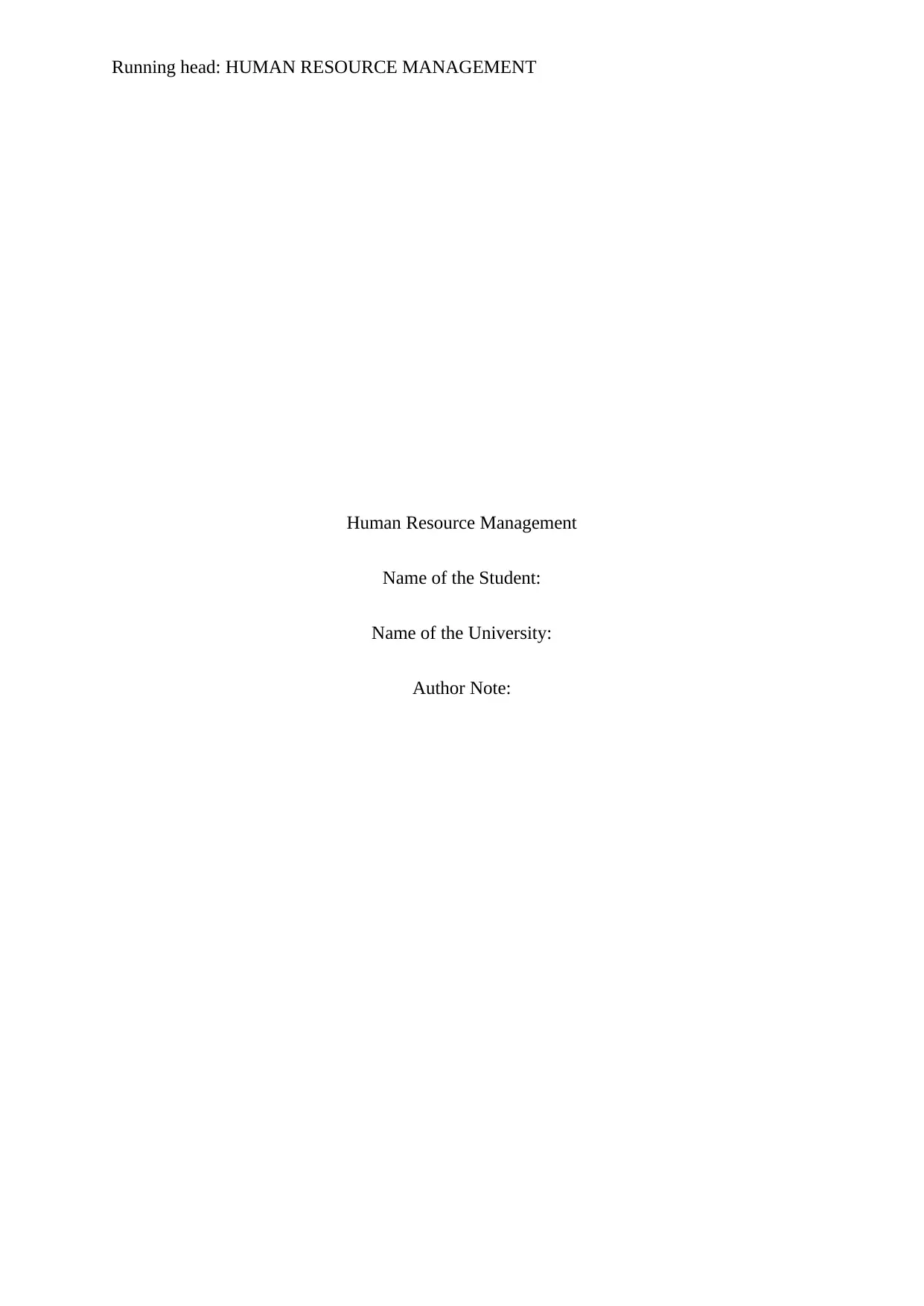
Running head: HUMAN RESOURCE MANAGEMENT
Human Resource Management
Name of the Student:
Name of the University:
Author Note:
Human Resource Management
Name of the Student:
Name of the University:
Author Note:
Paraphrase This Document
Need a fresh take? Get an instant paraphrase of this document with our AI Paraphraser
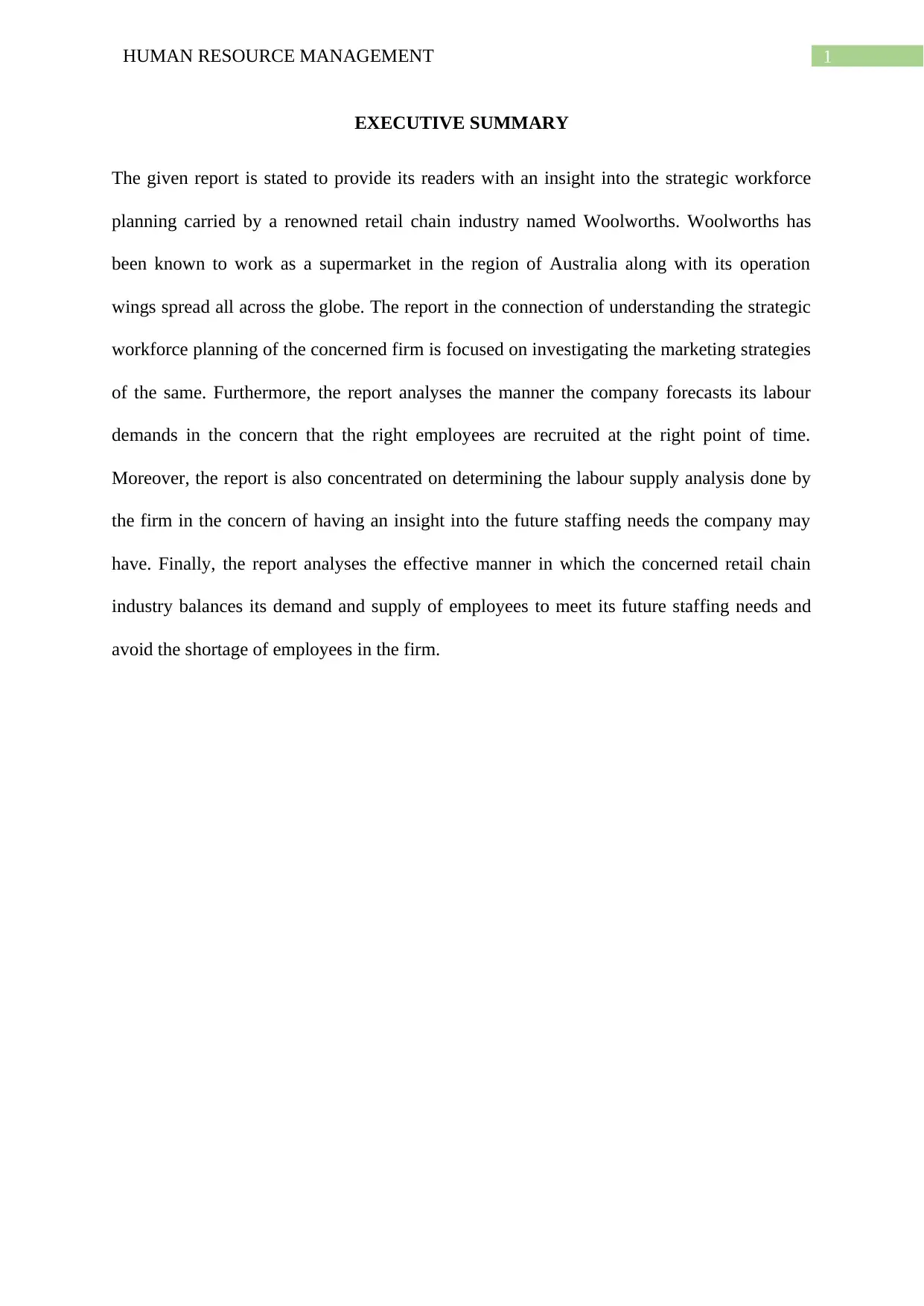
1HUMAN RESOURCE MANAGEMENT
EXECUTIVE SUMMARY
The given report is stated to provide its readers with an insight into the strategic workforce
planning carried by a renowned retail chain industry named Woolworths. Woolworths has
been known to work as a supermarket in the region of Australia along with its operation
wings spread all across the globe. The report in the connection of understanding the strategic
workforce planning of the concerned firm is focused on investigating the marketing strategies
of the same. Furthermore, the report analyses the manner the company forecasts its labour
demands in the concern that the right employees are recruited at the right point of time.
Moreover, the report is also concentrated on determining the labour supply analysis done by
the firm in the concern of having an insight into the future staffing needs the company may
have. Finally, the report analyses the effective manner in which the concerned retail chain
industry balances its demand and supply of employees to meet its future staffing needs and
avoid the shortage of employees in the firm.
EXECUTIVE SUMMARY
The given report is stated to provide its readers with an insight into the strategic workforce
planning carried by a renowned retail chain industry named Woolworths. Woolworths has
been known to work as a supermarket in the region of Australia along with its operation
wings spread all across the globe. The report in the connection of understanding the strategic
workforce planning of the concerned firm is focused on investigating the marketing strategies
of the same. Furthermore, the report analyses the manner the company forecasts its labour
demands in the concern that the right employees are recruited at the right point of time.
Moreover, the report is also concentrated on determining the labour supply analysis done by
the firm in the concern of having an insight into the future staffing needs the company may
have. Finally, the report analyses the effective manner in which the concerned retail chain
industry balances its demand and supply of employees to meet its future staffing needs and
avoid the shortage of employees in the firm.
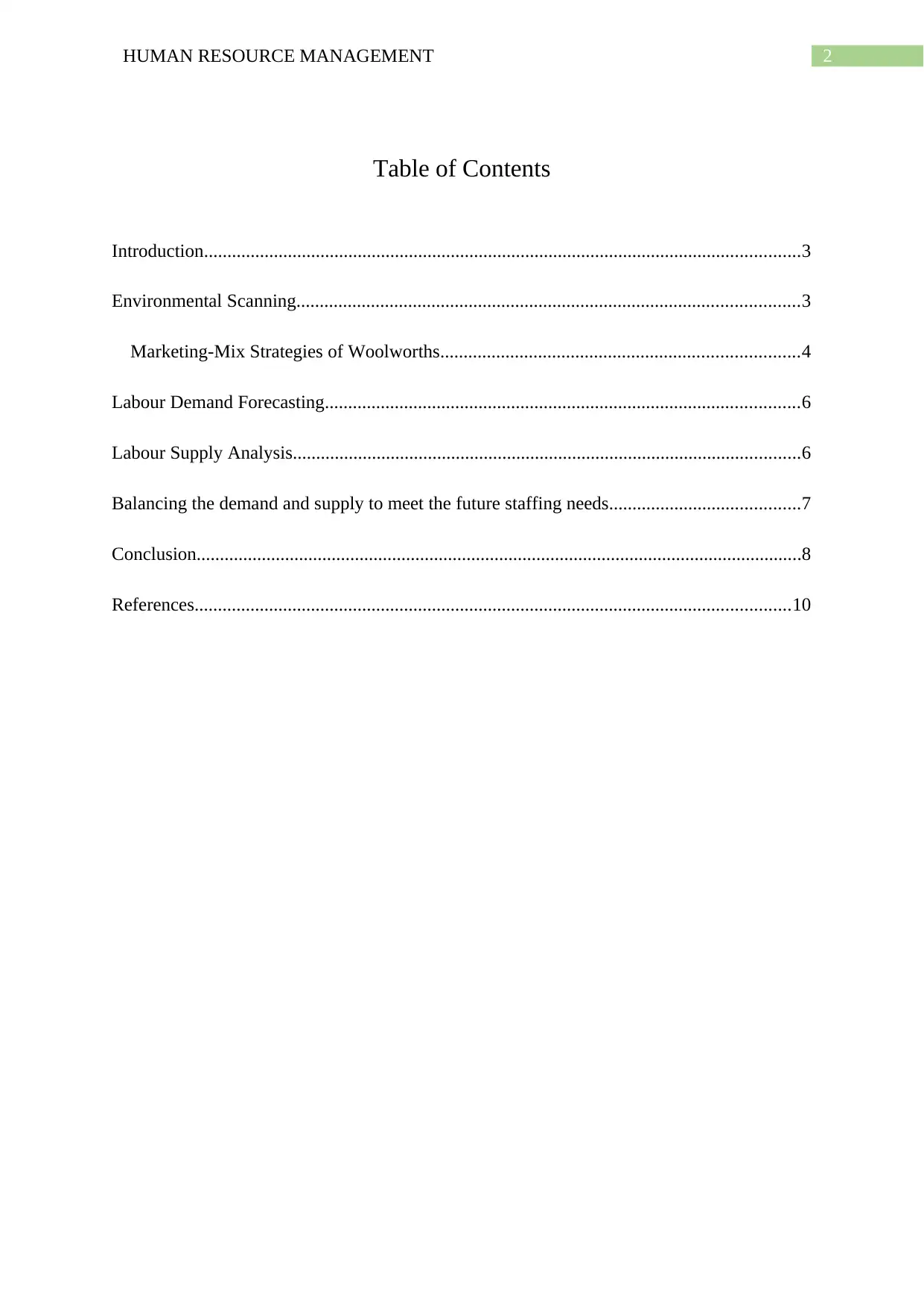
2HUMAN RESOURCE MANAGEMENT
Table of Contents
Introduction................................................................................................................................3
Environmental Scanning............................................................................................................3
Marketing-Mix Strategies of Woolworths.............................................................................4
Labour Demand Forecasting......................................................................................................6
Labour Supply Analysis.............................................................................................................6
Balancing the demand and supply to meet the future staffing needs.........................................7
Conclusion..................................................................................................................................8
References................................................................................................................................10
Table of Contents
Introduction................................................................................................................................3
Environmental Scanning............................................................................................................3
Marketing-Mix Strategies of Woolworths.............................................................................4
Labour Demand Forecasting......................................................................................................6
Labour Supply Analysis.............................................................................................................6
Balancing the demand and supply to meet the future staffing needs.........................................7
Conclusion..................................................................................................................................8
References................................................................................................................................10
⊘ This is a preview!⊘
Do you want full access?
Subscribe today to unlock all pages.

Trusted by 1+ million students worldwide
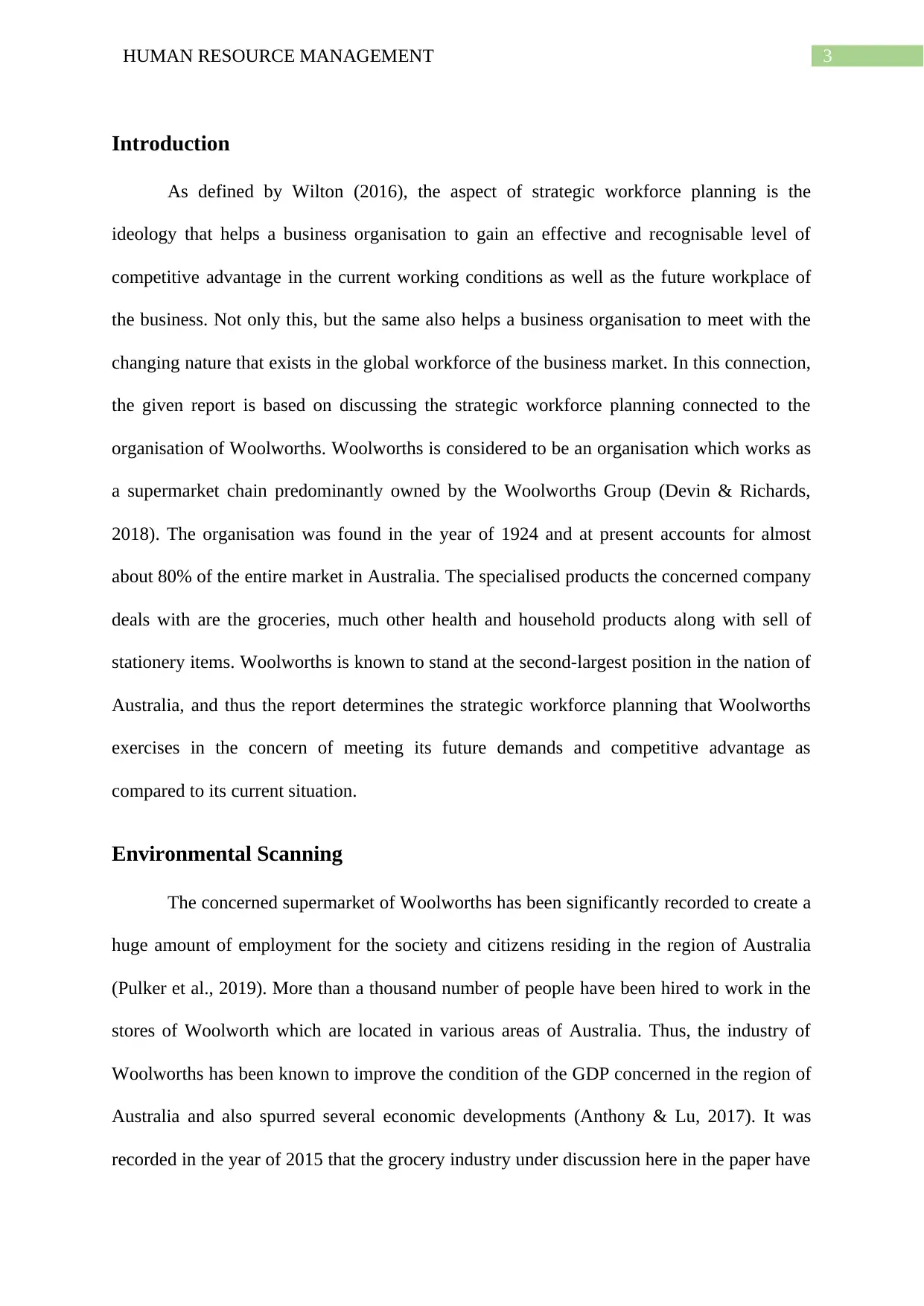
3HUMAN RESOURCE MANAGEMENT
Introduction
As defined by Wilton (2016), the aspect of strategic workforce planning is the
ideology that helps a business organisation to gain an effective and recognisable level of
competitive advantage in the current working conditions as well as the future workplace of
the business. Not only this, but the same also helps a business organisation to meet with the
changing nature that exists in the global workforce of the business market. In this connection,
the given report is based on discussing the strategic workforce planning connected to the
organisation of Woolworths. Woolworths is considered to be an organisation which works as
a supermarket chain predominantly owned by the Woolworths Group (Devin & Richards,
2018). The organisation was found in the year of 1924 and at present accounts for almost
about 80% of the entire market in Australia. The specialised products the concerned company
deals with are the groceries, much other health and household products along with sell of
stationery items. Woolworths is known to stand at the second-largest position in the nation of
Australia, and thus the report determines the strategic workforce planning that Woolworths
exercises in the concern of meeting its future demands and competitive advantage as
compared to its current situation.
Environmental Scanning
The concerned supermarket of Woolworths has been significantly recorded to create a
huge amount of employment for the society and citizens residing in the region of Australia
(Pulker et al., 2019). More than a thousand number of people have been hired to work in the
stores of Woolworth which are located in various areas of Australia. Thus, the industry of
Woolworths has been known to improve the condition of the GDP concerned in the region of
Australia and also spurred several economic developments (Anthony & Lu, 2017). It was
recorded in the year of 2015 that the grocery industry under discussion here in the paper have
Introduction
As defined by Wilton (2016), the aspect of strategic workforce planning is the
ideology that helps a business organisation to gain an effective and recognisable level of
competitive advantage in the current working conditions as well as the future workplace of
the business. Not only this, but the same also helps a business organisation to meet with the
changing nature that exists in the global workforce of the business market. In this connection,
the given report is based on discussing the strategic workforce planning connected to the
organisation of Woolworths. Woolworths is considered to be an organisation which works as
a supermarket chain predominantly owned by the Woolworths Group (Devin & Richards,
2018). The organisation was found in the year of 1924 and at present accounts for almost
about 80% of the entire market in Australia. The specialised products the concerned company
deals with are the groceries, much other health and household products along with sell of
stationery items. Woolworths is known to stand at the second-largest position in the nation of
Australia, and thus the report determines the strategic workforce planning that Woolworths
exercises in the concern of meeting its future demands and competitive advantage as
compared to its current situation.
Environmental Scanning
The concerned supermarket of Woolworths has been significantly recorded to create a
huge amount of employment for the society and citizens residing in the region of Australia
(Pulker et al., 2019). More than a thousand number of people have been hired to work in the
stores of Woolworth which are located in various areas of Australia. Thus, the industry of
Woolworths has been known to improve the condition of the GDP concerned in the region of
Australia and also spurred several economic developments (Anthony & Lu, 2017). It was
recorded in the year of 2015 that the grocery industry under discussion here in the paper have
Paraphrase This Document
Need a fresh take? Get an instant paraphrase of this document with our AI Paraphraser
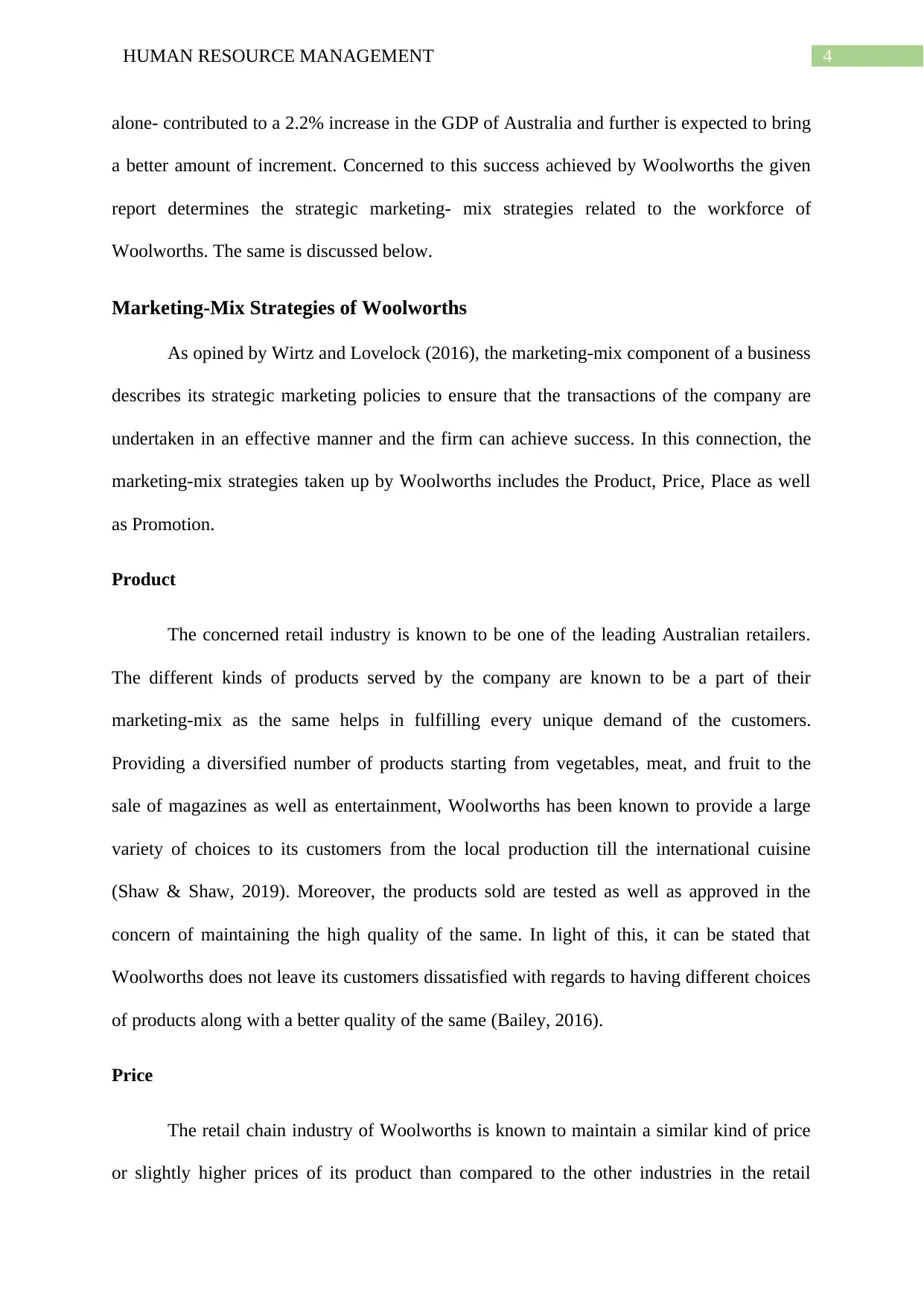
4HUMAN RESOURCE MANAGEMENT
alone- contributed to a 2.2% increase in the GDP of Australia and further is expected to bring
a better amount of increment. Concerned to this success achieved by Woolworths the given
report determines the strategic marketing- mix strategies related to the workforce of
Woolworths. The same is discussed below.
Marketing-Mix Strategies of Woolworths
As opined by Wirtz and Lovelock (2016), the marketing-mix component of a business
describes its strategic marketing policies to ensure that the transactions of the company are
undertaken in an effective manner and the firm can achieve success. In this connection, the
marketing-mix strategies taken up by Woolworths includes the Product, Price, Place as well
as Promotion.
Product
The concerned retail industry is known to be one of the leading Australian retailers.
The different kinds of products served by the company are known to be a part of their
marketing-mix as the same helps in fulfilling every unique demand of the customers.
Providing a diversified number of products starting from vegetables, meat, and fruit to the
sale of magazines as well as entertainment, Woolworths has been known to provide a large
variety of choices to its customers from the local production till the international cuisine
(Shaw & Shaw, 2019). Moreover, the products sold are tested as well as approved in the
concern of maintaining the high quality of the same. In light of this, it can be stated that
Woolworths does not leave its customers dissatisfied with regards to having different choices
of products along with a better quality of the same (Bailey, 2016).
Price
The retail chain industry of Woolworths is known to maintain a similar kind of price
or slightly higher prices of its product than compared to the other industries in the retail
alone- contributed to a 2.2% increase in the GDP of Australia and further is expected to bring
a better amount of increment. Concerned to this success achieved by Woolworths the given
report determines the strategic marketing- mix strategies related to the workforce of
Woolworths. The same is discussed below.
Marketing-Mix Strategies of Woolworths
As opined by Wirtz and Lovelock (2016), the marketing-mix component of a business
describes its strategic marketing policies to ensure that the transactions of the company are
undertaken in an effective manner and the firm can achieve success. In this connection, the
marketing-mix strategies taken up by Woolworths includes the Product, Price, Place as well
as Promotion.
Product
The concerned retail industry is known to be one of the leading Australian retailers.
The different kinds of products served by the company are known to be a part of their
marketing-mix as the same helps in fulfilling every unique demand of the customers.
Providing a diversified number of products starting from vegetables, meat, and fruit to the
sale of magazines as well as entertainment, Woolworths has been known to provide a large
variety of choices to its customers from the local production till the international cuisine
(Shaw & Shaw, 2019). Moreover, the products sold are tested as well as approved in the
concern of maintaining the high quality of the same. In light of this, it can be stated that
Woolworths does not leave its customers dissatisfied with regards to having different choices
of products along with a better quality of the same (Bailey, 2016).
Price
The retail chain industry of Woolworths is known to maintain a similar kind of price
or slightly higher prices of its product than compared to the other industries in the retail
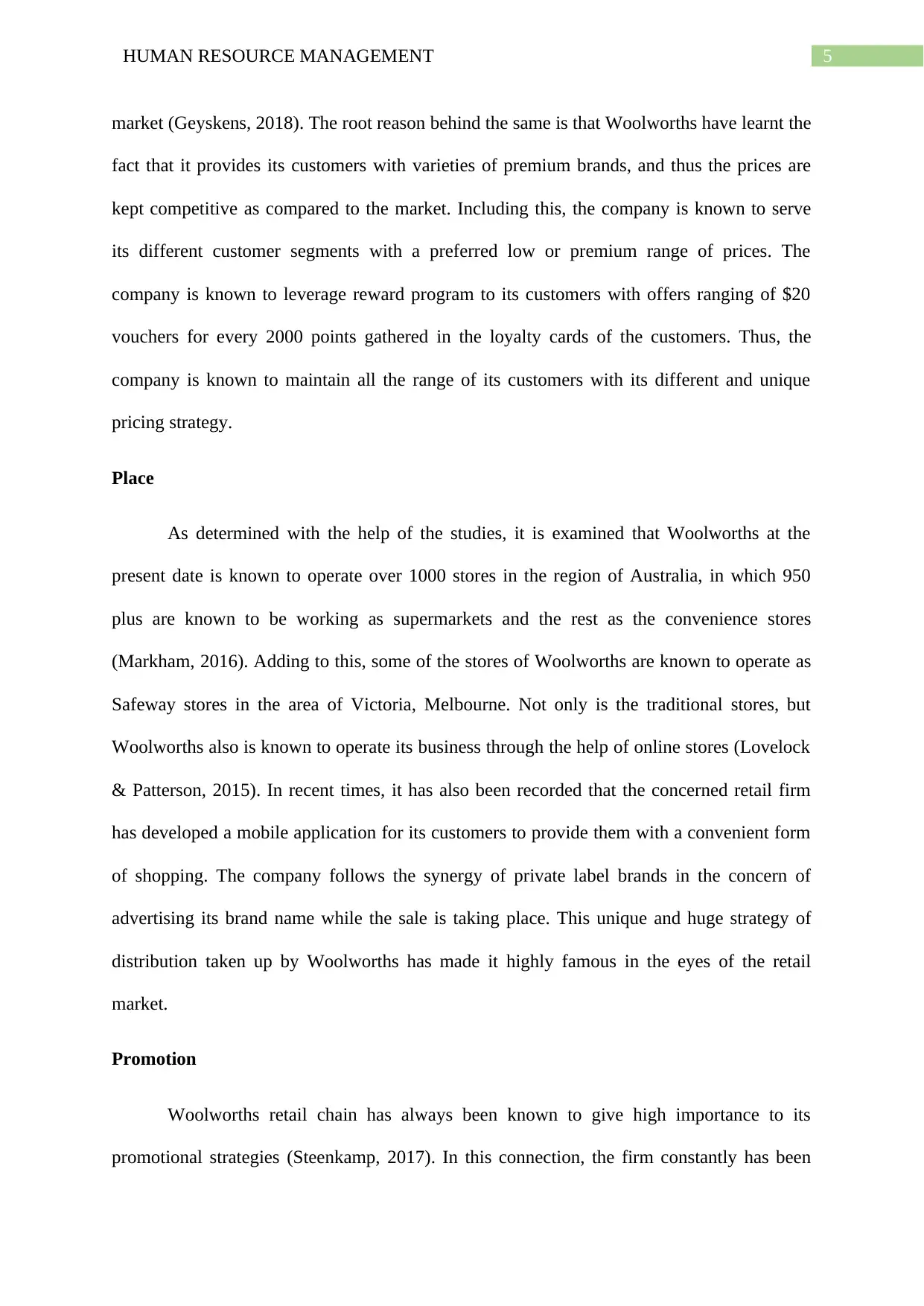
5HUMAN RESOURCE MANAGEMENT
market (Geyskens, 2018). The root reason behind the same is that Woolworths have learnt the
fact that it provides its customers with varieties of premium brands, and thus the prices are
kept competitive as compared to the market. Including this, the company is known to serve
its different customer segments with a preferred low or premium range of prices. The
company is known to leverage reward program to its customers with offers ranging of $20
vouchers for every 2000 points gathered in the loyalty cards of the customers. Thus, the
company is known to maintain all the range of its customers with its different and unique
pricing strategy.
Place
As determined with the help of the studies, it is examined that Woolworths at the
present date is known to operate over 1000 stores in the region of Australia, in which 950
plus are known to be working as supermarkets and the rest as the convenience stores
(Markham, 2016). Adding to this, some of the stores of Woolworths are known to operate as
Safeway stores in the area of Victoria, Melbourne. Not only is the traditional stores, but
Woolworths also is known to operate its business through the help of online stores (Lovelock
& Patterson, 2015). In recent times, it has also been recorded that the concerned retail firm
has developed a mobile application for its customers to provide them with a convenient form
of shopping. The company follows the synergy of private label brands in the concern of
advertising its brand name while the sale is taking place. This unique and huge strategy of
distribution taken up by Woolworths has made it highly famous in the eyes of the retail
market.
Promotion
Woolworths retail chain has always been known to give high importance to its
promotional strategies (Steenkamp, 2017). In this connection, the firm constantly has been
market (Geyskens, 2018). The root reason behind the same is that Woolworths have learnt the
fact that it provides its customers with varieties of premium brands, and thus the prices are
kept competitive as compared to the market. Including this, the company is known to serve
its different customer segments with a preferred low or premium range of prices. The
company is known to leverage reward program to its customers with offers ranging of $20
vouchers for every 2000 points gathered in the loyalty cards of the customers. Thus, the
company is known to maintain all the range of its customers with its different and unique
pricing strategy.
Place
As determined with the help of the studies, it is examined that Woolworths at the
present date is known to operate over 1000 stores in the region of Australia, in which 950
plus are known to be working as supermarkets and the rest as the convenience stores
(Markham, 2016). Adding to this, some of the stores of Woolworths are known to operate as
Safeway stores in the area of Victoria, Melbourne. Not only is the traditional stores, but
Woolworths also is known to operate its business through the help of online stores (Lovelock
& Patterson, 2015). In recent times, it has also been recorded that the concerned retail firm
has developed a mobile application for its customers to provide them with a convenient form
of shopping. The company follows the synergy of private label brands in the concern of
advertising its brand name while the sale is taking place. This unique and huge strategy of
distribution taken up by Woolworths has made it highly famous in the eyes of the retail
market.
Promotion
Woolworths retail chain has always been known to give high importance to its
promotional strategies (Steenkamp, 2017). In this connection, the firm constantly has been
⊘ This is a preview!⊘
Do you want full access?
Subscribe today to unlock all pages.

Trusted by 1+ million students worldwide
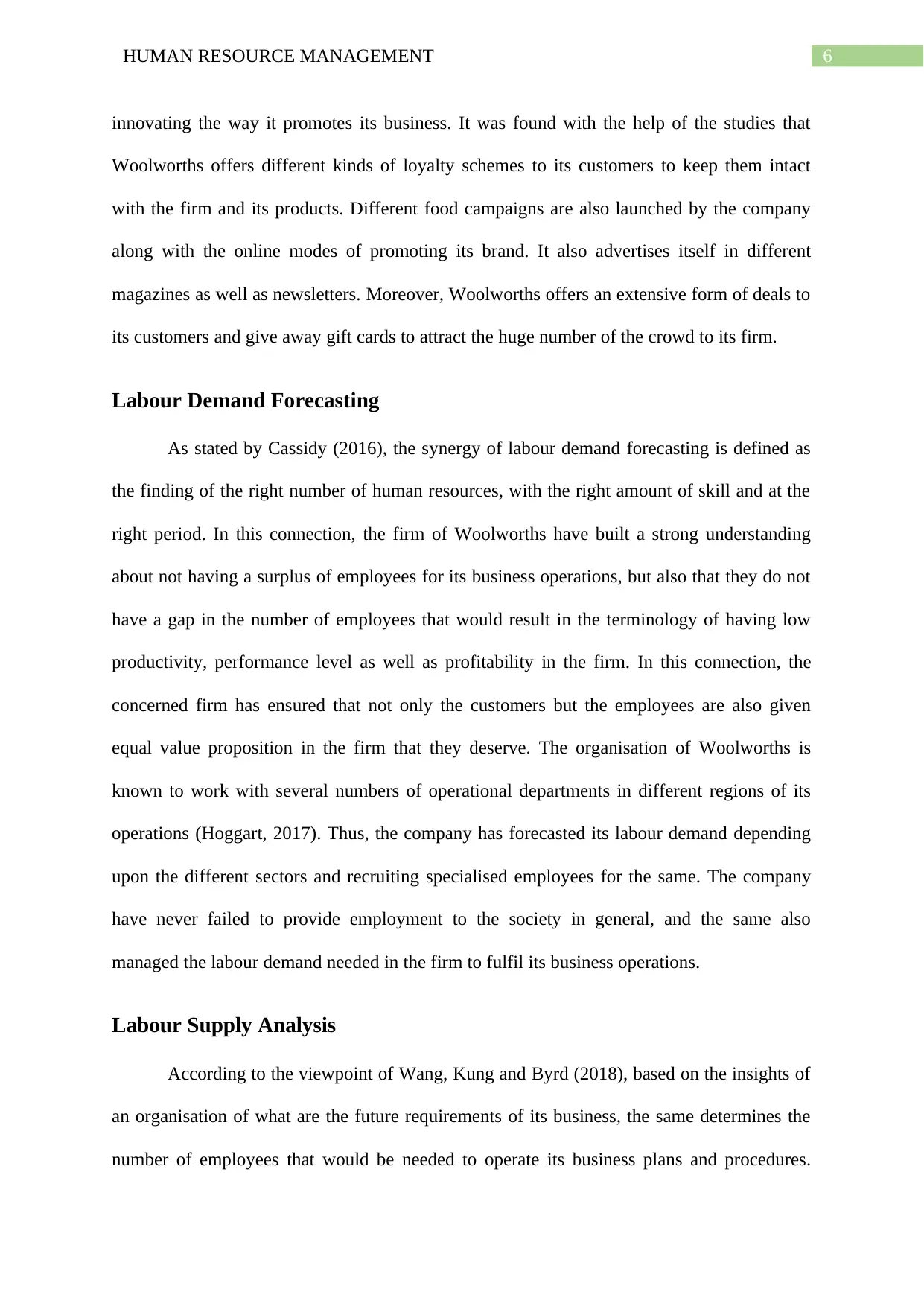
6HUMAN RESOURCE MANAGEMENT
innovating the way it promotes its business. It was found with the help of the studies that
Woolworths offers different kinds of loyalty schemes to its customers to keep them intact
with the firm and its products. Different food campaigns are also launched by the company
along with the online modes of promoting its brand. It also advertises itself in different
magazines as well as newsletters. Moreover, Woolworths offers an extensive form of deals to
its customers and give away gift cards to attract the huge number of the crowd to its firm.
Labour Demand Forecasting
As stated by Cassidy (2016), the synergy of labour demand forecasting is defined as
the finding of the right number of human resources, with the right amount of skill and at the
right period. In this connection, the firm of Woolworths have built a strong understanding
about not having a surplus of employees for its business operations, but also that they do not
have a gap in the number of employees that would result in the terminology of having low
productivity, performance level as well as profitability in the firm. In this connection, the
concerned firm has ensured that not only the customers but the employees are also given
equal value proposition in the firm that they deserve. The organisation of Woolworths is
known to work with several numbers of operational departments in different regions of its
operations (Hoggart, 2017). Thus, the company has forecasted its labour demand depending
upon the different sectors and recruiting specialised employees for the same. The company
have never failed to provide employment to the society in general, and the same also
managed the labour demand needed in the firm to fulfil its business operations.
Labour Supply Analysis
According to the viewpoint of Wang, Kung and Byrd (2018), based on the insights of
an organisation of what are the future requirements of its business, the same determines the
number of employees that would be needed to operate its business plans and procedures.
innovating the way it promotes its business. It was found with the help of the studies that
Woolworths offers different kinds of loyalty schemes to its customers to keep them intact
with the firm and its products. Different food campaigns are also launched by the company
along with the online modes of promoting its brand. It also advertises itself in different
magazines as well as newsletters. Moreover, Woolworths offers an extensive form of deals to
its customers and give away gift cards to attract the huge number of the crowd to its firm.
Labour Demand Forecasting
As stated by Cassidy (2016), the synergy of labour demand forecasting is defined as
the finding of the right number of human resources, with the right amount of skill and at the
right period. In this connection, the firm of Woolworths have built a strong understanding
about not having a surplus of employees for its business operations, but also that they do not
have a gap in the number of employees that would result in the terminology of having low
productivity, performance level as well as profitability in the firm. In this connection, the
concerned firm has ensured that not only the customers but the employees are also given
equal value proposition in the firm that they deserve. The organisation of Woolworths is
known to work with several numbers of operational departments in different regions of its
operations (Hoggart, 2017). Thus, the company has forecasted its labour demand depending
upon the different sectors and recruiting specialised employees for the same. The company
have never failed to provide employment to the society in general, and the same also
managed the labour demand needed in the firm to fulfil its business operations.
Labour Supply Analysis
According to the viewpoint of Wang, Kung and Byrd (2018), based on the insights of
an organisation of what are the future requirements of its business, the same determines the
number of employees that would be needed to operate its business plans and procedures.
Paraphrase This Document
Need a fresh take? Get an instant paraphrase of this document with our AI Paraphraser
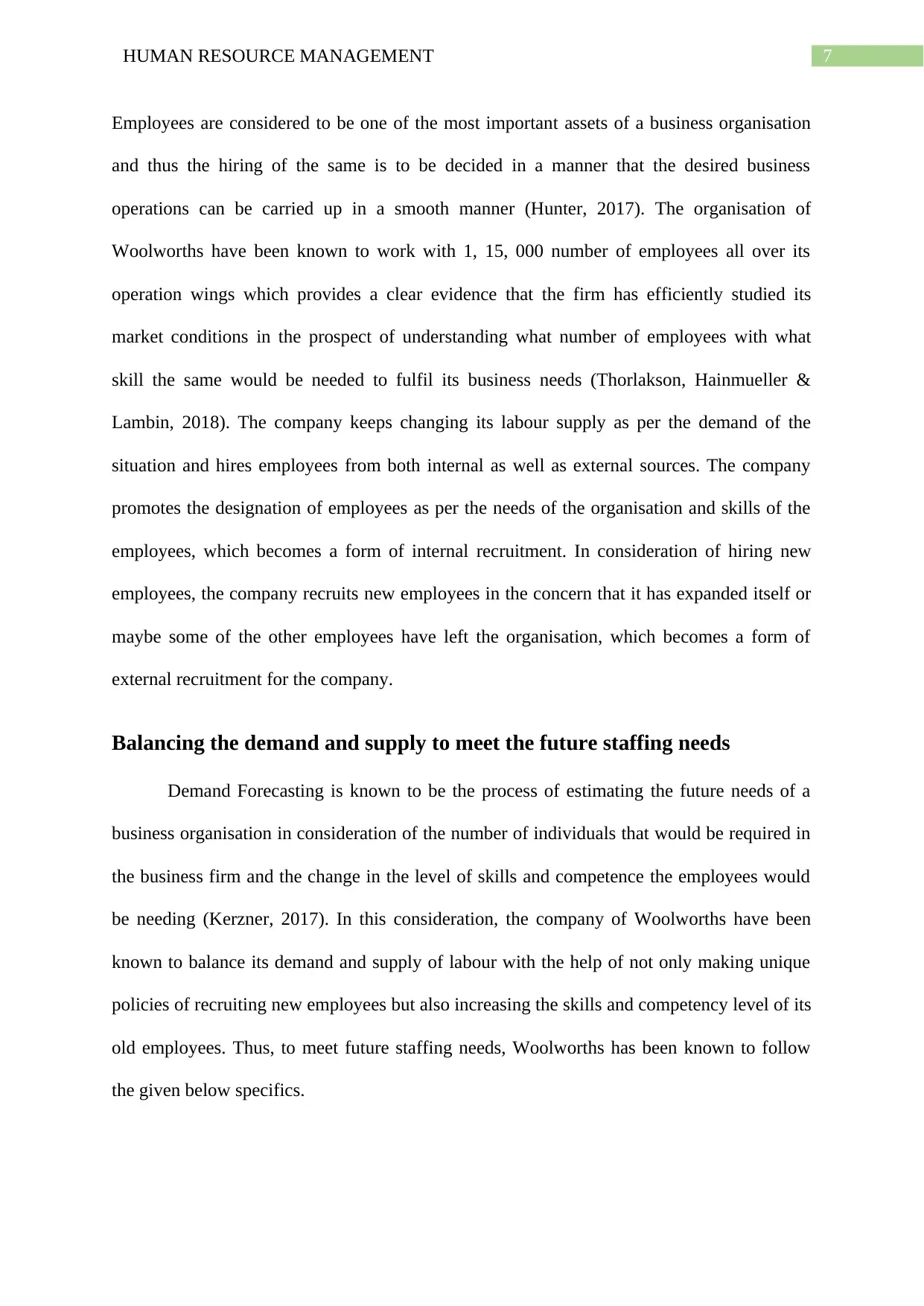
7HUMAN RESOURCE MANAGEMENT
Employees are considered to be one of the most important assets of a business organisation
and thus the hiring of the same is to be decided in a manner that the desired business
operations can be carried up in a smooth manner (Hunter, 2017). The organisation of
Woolworths have been known to work with 1, 15, 000 number of employees all over its
operation wings which provides a clear evidence that the firm has efficiently studied its
market conditions in the prospect of understanding what number of employees with what
skill the same would be needed to fulfil its business needs (Thorlakson, Hainmueller &
Lambin, 2018). The company keeps changing its labour supply as per the demand of the
situation and hires employees from both internal as well as external sources. The company
promotes the designation of employees as per the needs of the organisation and skills of the
employees, which becomes a form of internal recruitment. In consideration of hiring new
employees, the company recruits new employees in the concern that it has expanded itself or
maybe some of the other employees have left the organisation, which becomes a form of
external recruitment for the company.
Balancing the demand and supply to meet the future staffing needs
Demand Forecasting is known to be the process of estimating the future needs of a
business organisation in consideration of the number of individuals that would be required in
the business firm and the change in the level of skills and competence the employees would
be needing (Kerzner, 2017). In this consideration, the company of Woolworths have been
known to balance its demand and supply of labour with the help of not only making unique
policies of recruiting new employees but also increasing the skills and competency level of its
old employees. Thus, to meet future staffing needs, Woolworths has been known to follow
the given below specifics.
Employees are considered to be one of the most important assets of a business organisation
and thus the hiring of the same is to be decided in a manner that the desired business
operations can be carried up in a smooth manner (Hunter, 2017). The organisation of
Woolworths have been known to work with 1, 15, 000 number of employees all over its
operation wings which provides a clear evidence that the firm has efficiently studied its
market conditions in the prospect of understanding what number of employees with what
skill the same would be needed to fulfil its business needs (Thorlakson, Hainmueller &
Lambin, 2018). The company keeps changing its labour supply as per the demand of the
situation and hires employees from both internal as well as external sources. The company
promotes the designation of employees as per the needs of the organisation and skills of the
employees, which becomes a form of internal recruitment. In consideration of hiring new
employees, the company recruits new employees in the concern that it has expanded itself or
maybe some of the other employees have left the organisation, which becomes a form of
external recruitment for the company.
Balancing the demand and supply to meet the future staffing needs
Demand Forecasting is known to be the process of estimating the future needs of a
business organisation in consideration of the number of individuals that would be required in
the business firm and the change in the level of skills and competence the employees would
be needing (Kerzner, 2017). In this consideration, the company of Woolworths have been
known to balance its demand and supply of labour with the help of not only making unique
policies of recruiting new employees but also increasing the skills and competency level of its
old employees. Thus, to meet future staffing needs, Woolworths has been known to follow
the given below specifics.
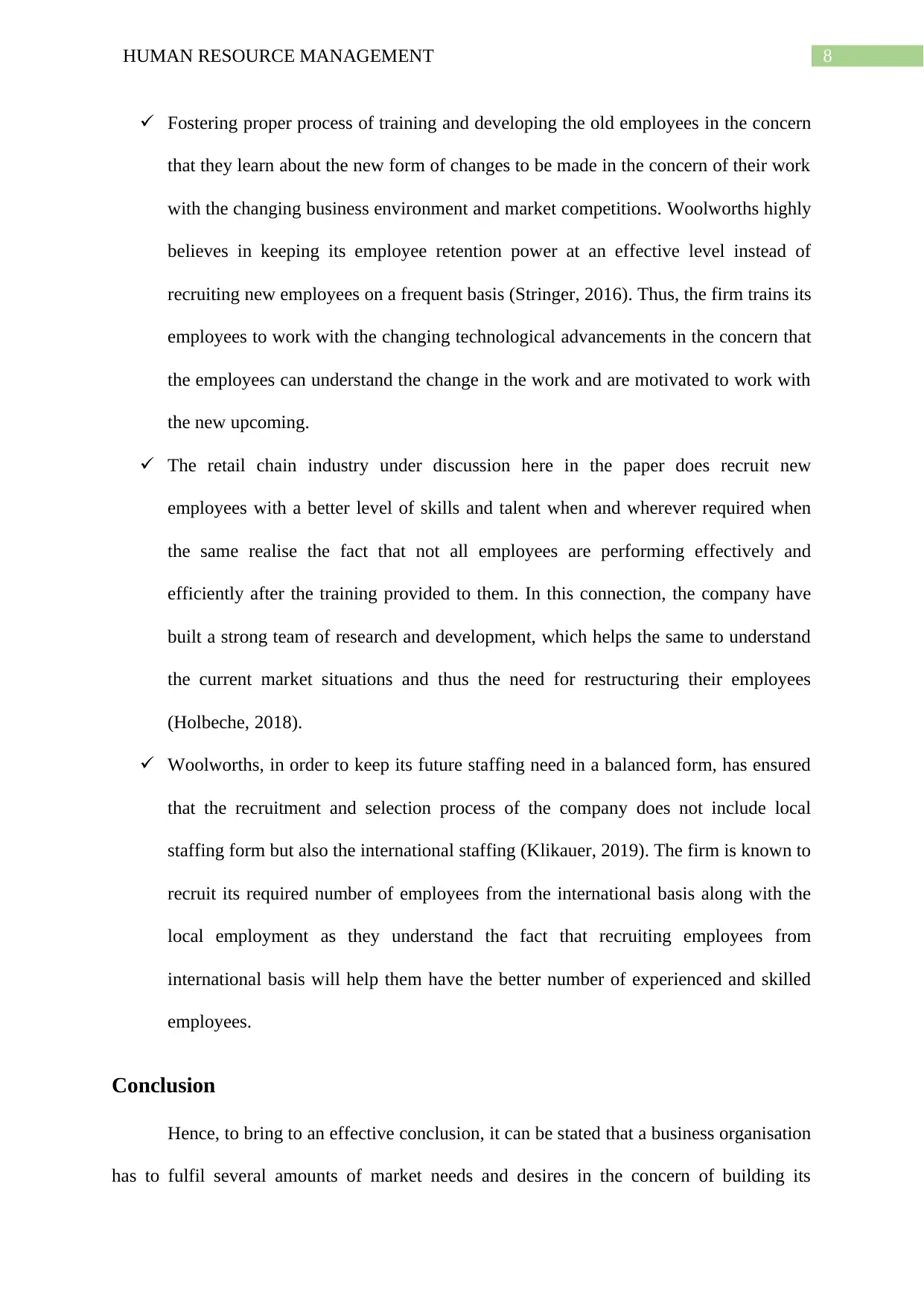
8HUMAN RESOURCE MANAGEMENT
Fostering proper process of training and developing the old employees in the concern
that they learn about the new form of changes to be made in the concern of their work
with the changing business environment and market competitions. Woolworths highly
believes in keeping its employee retention power at an effective level instead of
recruiting new employees on a frequent basis (Stringer, 2016). Thus, the firm trains its
employees to work with the changing technological advancements in the concern that
the employees can understand the change in the work and are motivated to work with
the new upcoming.
The retail chain industry under discussion here in the paper does recruit new
employees with a better level of skills and talent when and wherever required when
the same realise the fact that not all employees are performing effectively and
efficiently after the training provided to them. In this connection, the company have
built a strong team of research and development, which helps the same to understand
the current market situations and thus the need for restructuring their employees
(Holbeche, 2018).
Woolworths, in order to keep its future staffing need in a balanced form, has ensured
that the recruitment and selection process of the company does not include local
staffing form but also the international staffing (Klikauer, 2019). The firm is known to
recruit its required number of employees from the international basis along with the
local employment as they understand the fact that recruiting employees from
international basis will help them have the better number of experienced and skilled
employees.
Conclusion
Hence, to bring to an effective conclusion, it can be stated that a business organisation
has to fulfil several amounts of market needs and desires in the concern of building its
Fostering proper process of training and developing the old employees in the concern
that they learn about the new form of changes to be made in the concern of their work
with the changing business environment and market competitions. Woolworths highly
believes in keeping its employee retention power at an effective level instead of
recruiting new employees on a frequent basis (Stringer, 2016). Thus, the firm trains its
employees to work with the changing technological advancements in the concern that
the employees can understand the change in the work and are motivated to work with
the new upcoming.
The retail chain industry under discussion here in the paper does recruit new
employees with a better level of skills and talent when and wherever required when
the same realise the fact that not all employees are performing effectively and
efficiently after the training provided to them. In this connection, the company have
built a strong team of research and development, which helps the same to understand
the current market situations and thus the need for restructuring their employees
(Holbeche, 2018).
Woolworths, in order to keep its future staffing need in a balanced form, has ensured
that the recruitment and selection process of the company does not include local
staffing form but also the international staffing (Klikauer, 2019). The firm is known to
recruit its required number of employees from the international basis along with the
local employment as they understand the fact that recruiting employees from
international basis will help them have the better number of experienced and skilled
employees.
Conclusion
Hence, to bring to an effective conclusion, it can be stated that a business organisation
has to fulfil several amounts of market needs and desires in the concern of building its
⊘ This is a preview!⊘
Do you want full access?
Subscribe today to unlock all pages.

Trusted by 1+ million students worldwide
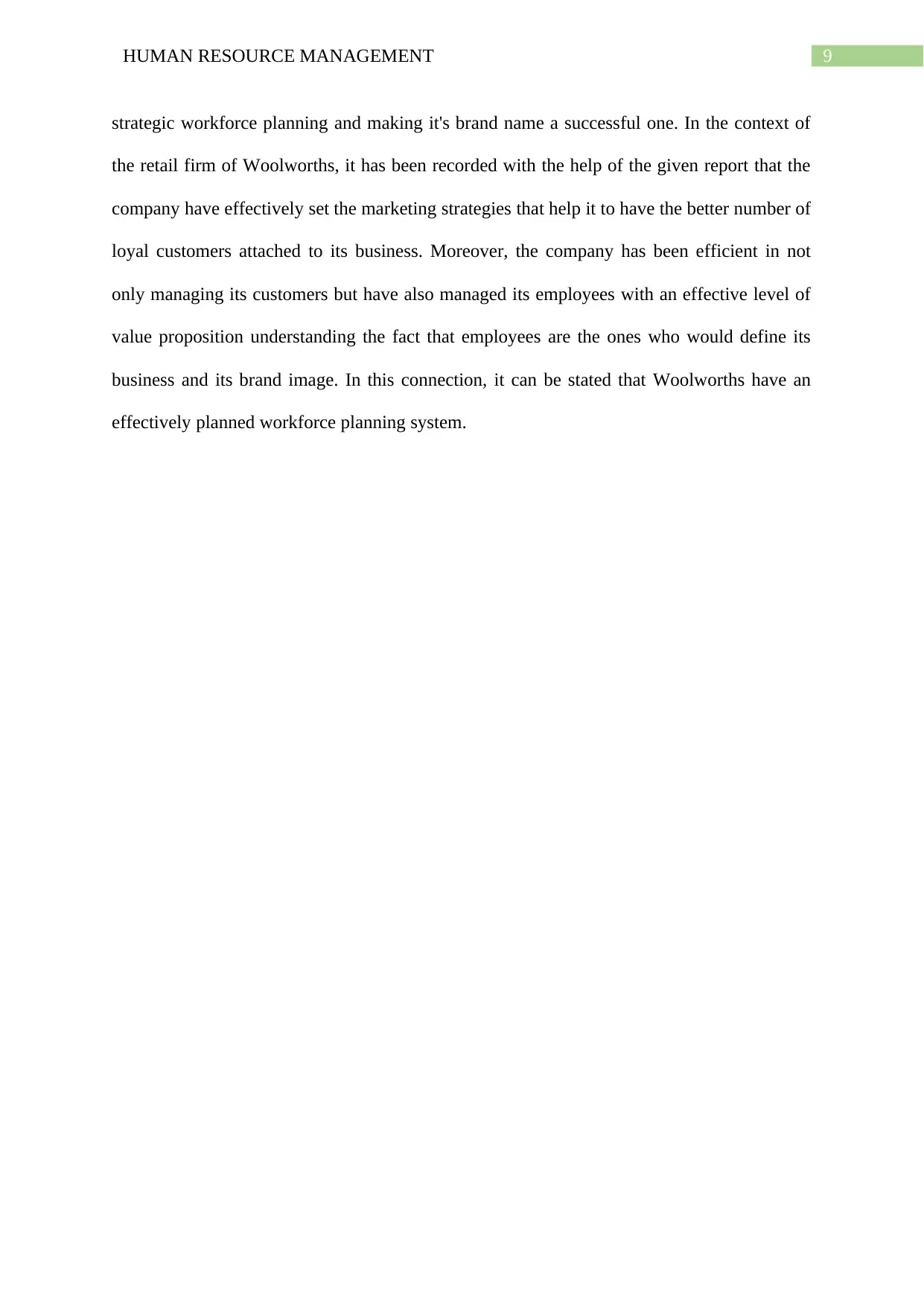
9HUMAN RESOURCE MANAGEMENT
strategic workforce planning and making it's brand name a successful one. In the context of
the retail firm of Woolworths, it has been recorded with the help of the given report that the
company have effectively set the marketing strategies that help it to have the better number of
loyal customers attached to its business. Moreover, the company has been efficient in not
only managing its customers but have also managed its employees with an effective level of
value proposition understanding the fact that employees are the ones who would define its
business and its brand image. In this connection, it can be stated that Woolworths have an
effectively planned workforce planning system.
strategic workforce planning and making it's brand name a successful one. In the context of
the retail firm of Woolworths, it has been recorded with the help of the given report that the
company have effectively set the marketing strategies that help it to have the better number of
loyal customers attached to its business. Moreover, the company has been efficient in not
only managing its customers but have also managed its employees with an effective level of
value proposition understanding the fact that employees are the ones who would define its
business and its brand image. In this connection, it can be stated that Woolworths have an
effectively planned workforce planning system.
Paraphrase This Document
Need a fresh take? Get an instant paraphrase of this document with our AI Paraphraser
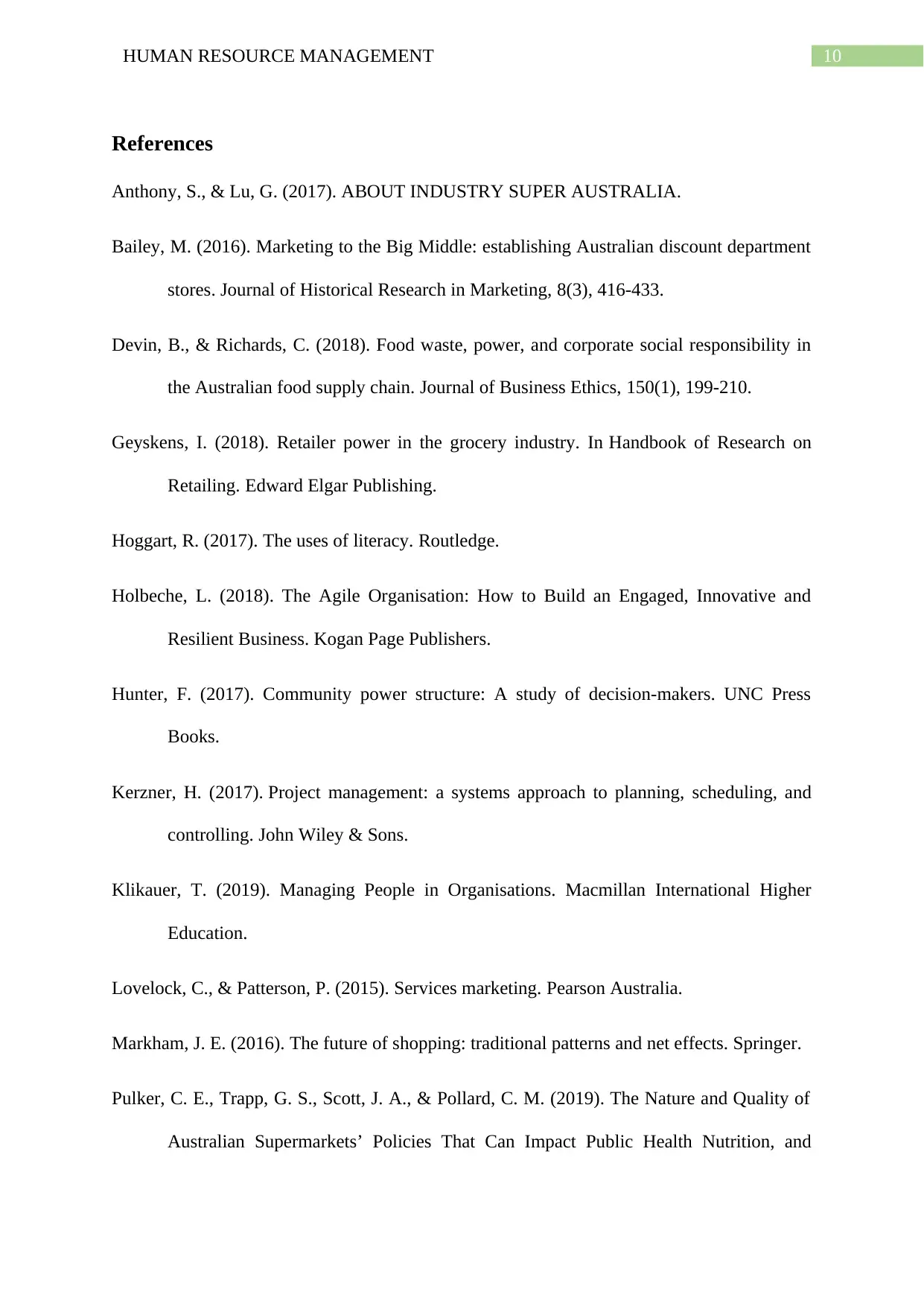
10HUMAN RESOURCE MANAGEMENT
References
Anthony, S., & Lu, G. (2017). ABOUT INDUSTRY SUPER AUSTRALIA.
Bailey, M. (2016). Marketing to the Big Middle: establishing Australian discount department
stores. Journal of Historical Research in Marketing, 8(3), 416-433.
Devin, B., & Richards, C. (2018). Food waste, power, and corporate social responsibility in
the Australian food supply chain. Journal of Business Ethics, 150(1), 199-210.
Geyskens, I. (2018). Retailer power in the grocery industry. In Handbook of Research on
Retailing. Edward Elgar Publishing.
Hoggart, R. (2017). The uses of literacy. Routledge.
Holbeche, L. (2018). The Agile Organisation: How to Build an Engaged, Innovative and
Resilient Business. Kogan Page Publishers.
Hunter, F. (2017). Community power structure: A study of decision-makers. UNC Press
Books.
Kerzner, H. (2017). Project management: a systems approach to planning, scheduling, and
controlling. John Wiley & Sons.
Klikauer, T. (2019). Managing People in Organisations. Macmillan International Higher
Education.
Lovelock, C., & Patterson, P. (2015). Services marketing. Pearson Australia.
Markham, J. E. (2016). The future of shopping: traditional patterns and net effects. Springer.
Pulker, C. E., Trapp, G. S., Scott, J. A., & Pollard, C. M. (2019). The Nature and Quality of
Australian Supermarkets’ Policies That Can Impact Public Health Nutrition, and
References
Anthony, S., & Lu, G. (2017). ABOUT INDUSTRY SUPER AUSTRALIA.
Bailey, M. (2016). Marketing to the Big Middle: establishing Australian discount department
stores. Journal of Historical Research in Marketing, 8(3), 416-433.
Devin, B., & Richards, C. (2018). Food waste, power, and corporate social responsibility in
the Australian food supply chain. Journal of Business Ethics, 150(1), 199-210.
Geyskens, I. (2018). Retailer power in the grocery industry. In Handbook of Research on
Retailing. Edward Elgar Publishing.
Hoggart, R. (2017). The uses of literacy. Routledge.
Holbeche, L. (2018). The Agile Organisation: How to Build an Engaged, Innovative and
Resilient Business. Kogan Page Publishers.
Hunter, F. (2017). Community power structure: A study of decision-makers. UNC Press
Books.
Kerzner, H. (2017). Project management: a systems approach to planning, scheduling, and
controlling. John Wiley & Sons.
Klikauer, T. (2019). Managing People in Organisations. Macmillan International Higher
Education.
Lovelock, C., & Patterson, P. (2015). Services marketing. Pearson Australia.
Markham, J. E. (2016). The future of shopping: traditional patterns and net effects. Springer.
Pulker, C. E., Trapp, G. S., Scott, J. A., & Pollard, C. M. (2019). The Nature and Quality of
Australian Supermarkets’ Policies That Can Impact Public Health Nutrition, and
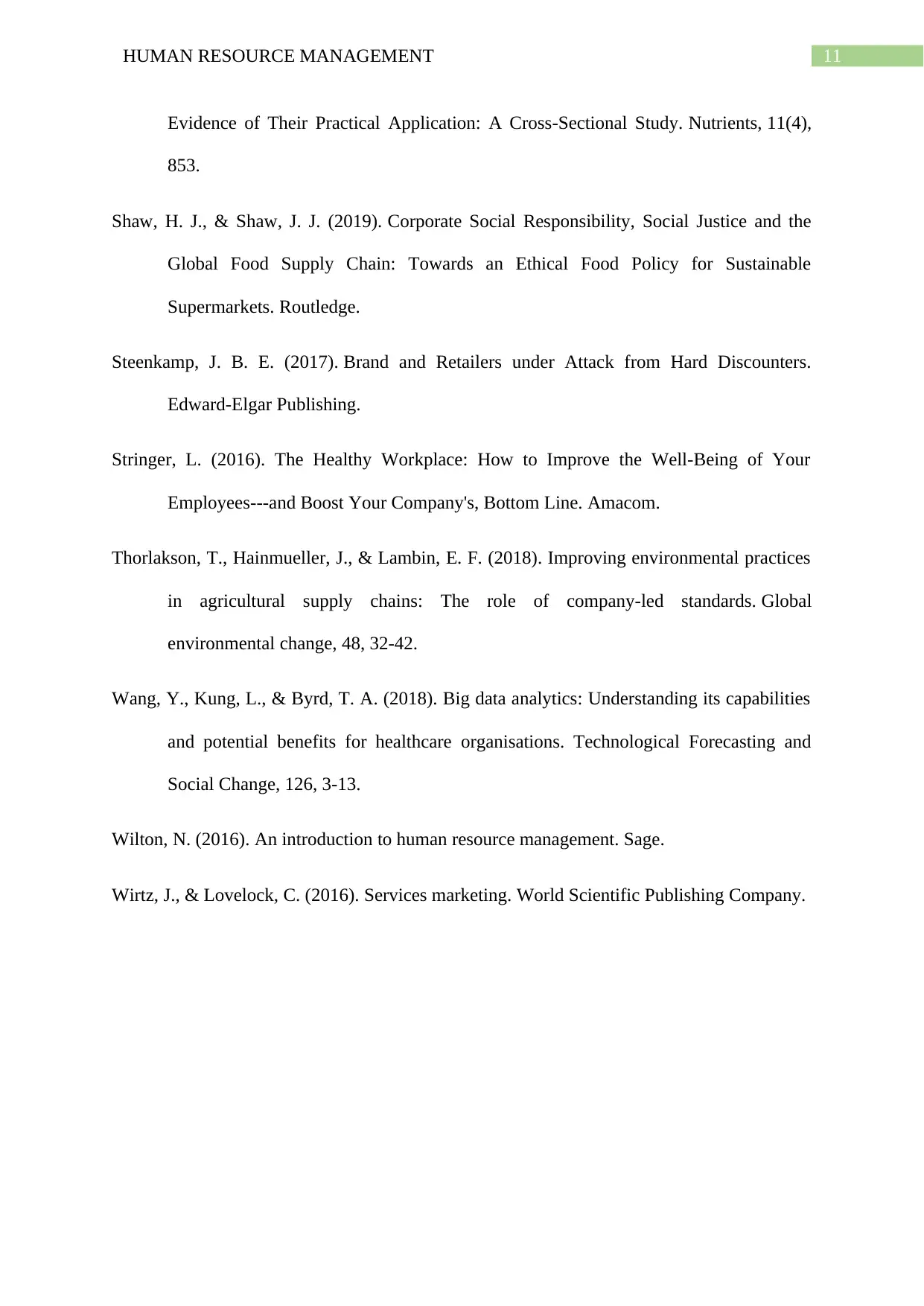
11HUMAN RESOURCE MANAGEMENT
Evidence of Their Practical Application: A Cross-Sectional Study. Nutrients, 11(4),
853.
Shaw, H. J., & Shaw, J. J. (2019). Corporate Social Responsibility, Social Justice and the
Global Food Supply Chain: Towards an Ethical Food Policy for Sustainable
Supermarkets. Routledge.
Steenkamp, J. B. E. (2017). Brand and Retailers under Attack from Hard Discounters.
Edward-Elgar Publishing.
Stringer, L. (2016). The Healthy Workplace: How to Improve the Well-Being of Your
Employees---and Boost Your Company's, Bottom Line. Amacom.
Thorlakson, T., Hainmueller, J., & Lambin, E. F. (2018). Improving environmental practices
in agricultural supply chains: The role of company-led standards. Global
environmental change, 48, 32-42.
Wang, Y., Kung, L., & Byrd, T. A. (2018). Big data analytics: Understanding its capabilities
and potential benefits for healthcare organisations. Technological Forecasting and
Social Change, 126, 3-13.
Wilton, N. (2016). An introduction to human resource management. Sage.
Wirtz, J., & Lovelock, C. (2016). Services marketing. World Scientific Publishing Company.
Evidence of Their Practical Application: A Cross-Sectional Study. Nutrients, 11(4),
853.
Shaw, H. J., & Shaw, J. J. (2019). Corporate Social Responsibility, Social Justice and the
Global Food Supply Chain: Towards an Ethical Food Policy for Sustainable
Supermarkets. Routledge.
Steenkamp, J. B. E. (2017). Brand and Retailers under Attack from Hard Discounters.
Edward-Elgar Publishing.
Stringer, L. (2016). The Healthy Workplace: How to Improve the Well-Being of Your
Employees---and Boost Your Company's, Bottom Line. Amacom.
Thorlakson, T., Hainmueller, J., & Lambin, E. F. (2018). Improving environmental practices
in agricultural supply chains: The role of company-led standards. Global
environmental change, 48, 32-42.
Wang, Y., Kung, L., & Byrd, T. A. (2018). Big data analytics: Understanding its capabilities
and potential benefits for healthcare organisations. Technological Forecasting and
Social Change, 126, 3-13.
Wilton, N. (2016). An introduction to human resource management. Sage.
Wirtz, J., & Lovelock, C. (2016). Services marketing. World Scientific Publishing Company.
⊘ This is a preview!⊘
Do you want full access?
Subscribe today to unlock all pages.

Trusted by 1+ million students worldwide
1 out of 12
Related Documents
Your All-in-One AI-Powered Toolkit for Academic Success.
+13062052269
info@desklib.com
Available 24*7 on WhatsApp / Email
![[object Object]](/_next/static/media/star-bottom.7253800d.svg)
Unlock your academic potential
Copyright © 2020–2025 A2Z Services. All Rights Reserved. Developed and managed by ZUCOL.




